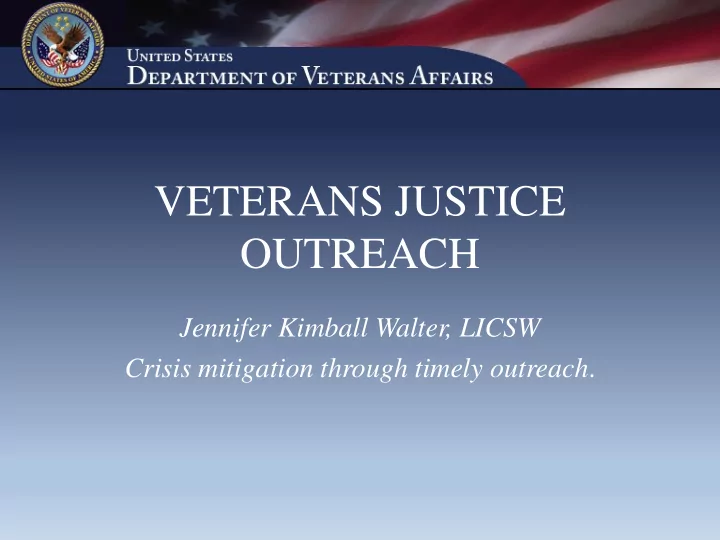

VETERANS JUSTICE OUTREACH Jennifer Kimball Walter, LICSW Crisis mitigation through timely outreach .
The VJO Mission • To avoid the unnecessary criminalization of mental illness and extended incarceration among Veterans by ensuring that eligible justice-involved Veterans have timely access to VHA services as clinically indicated. • VJO Specialists are responsible for direct outreach, assessment, and case management for justice- involved Veterans in local courts and jails, and liaison with local justice system partners.
Who we serve • Justice-Involved Veterans – A Veteran in contact with local law enforcement. – A Veteran in a local jail – A Veteran in adjudication
History • 1995 - The Substance Abuse and Mental Health Services Administration (SAMHSA) partnered with the Center for Mental Health Services’ National GAINS Center. – Began an implementation and evaluation program of jail diversion initiatives. – Early identification and outreach found to be key.
History • 2003 - The President’s New Freedom Commission on Mental Health called for mental health treatment to be readily available in Communities so that mental health consumers no longer faced unemployment, homelessness, or incarceration because of untreated mental illness. – Identified policies to maximize the utility of existing resources. – Improve coordination of treatments and services. – Promote successful community integration of Veterans.
History • 2008 – SAMHSA and the National GAINS Center funded state and local pilot initiatives to connect justice-involved Veterans with needed mental health and substance abuse services.
Sequential Intercept Model • Used as a roadmap by the VJO • Indicates that people move through the justice system in predictable ways. • Allows for multiple opportunities of intercept. • Looks to identify Veterans in need and move them away from avoidable contact with the justice system and into the appropriate treatment.
Sequential Intercept Model - Intercepts Intercept Point 1 Law enforcement and emergency services Intercept Point 2 Post arrest: Internal detention and initial hearing Intercept Point 3 Post-initial hearings: jail and courts Intercept Point 4 Reentry from jails, state prisons & forensic hospitalization Intercept Point 5 Community corrections & support (Probation and Parole)
Sequential Intercept Model VA VJO LAW JAIL COURT ENFORCEMENT
What the VJO Can and Cannot do. Can… Cannot… Reach out to law enforcement, jails, • • Accept Custody and courts; • Guarantee program acceptance Provide comprehensive healthcare • services; • Advocate for legislation With Veteran consent, communicate • • Perform forensic psychiatric or essentials (attendance, progress, tx psychological evaluation for the court; testing, d/c plan); Serve all veteran eras; • Do Diversion Programming, accept • Function as court team member; custody; • Assess veteran’s healthcare needs, • • Serve VHA ineligible Veterans. identify appropriate VA and non-VA services; Refer and link veteran to services; • Provide EBT for court-monitored • veterans.
Questions?
Recommend
More recommend